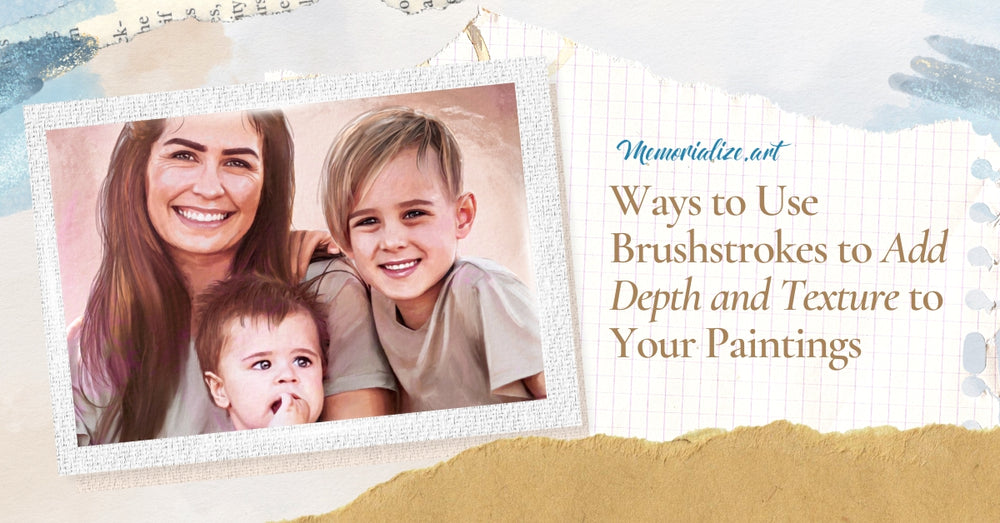5 Ways to Use Brushstrokes to Add Depth and Texture to Your Paintings

Artistry takes many forms, and perhaps there is no more visceral or profound method of expression than painting. Among the most influential aspects of creating a painting is the way you apply your brush strokes. Brush strokes painting can be much more than a simple means to an end; they are an integral part of your work, the signature that identifies your unique approach. How you handle your brush can add drama, create mood, and produce a compelling narrative within the frame of your artwork. This guide will discuss five key ways to use brush strokes to bring depth and texture to your paintings.

What are Brush Strokes?
At its most basic, a brush stroke is the mark that your paintbrush leaves on the canvas. But it's so much more than that. They are the DNA of your artistic style, your unique way of applying technique, and expressing your creative intent. Brush strokes can range from a soft touch that barely grazes the canvas to strong, bold applications of color that command attention.
Why are Brush Strokes Important in Painting?
Brush strokes are like the words used by an author. Just as the choice of words can drastically change the tone and meaning of a story, the type of brush strokes can alter the mood and perception of a painting. They add depth, texture, and personality to the painting, transforming it from a flat, one-dimensional image into a vibrant, multi-dimensional masterpiece.
What are the Different Types of Brush Strokes?
Each brush stroke brings a different emotion, texture, and depth. Here are a few types that artists commonly use to breathe life into their paintings:
Smooth/Blending Brush Stroke

Get Your Custom Watercolor Family Portrait Here
A smooth brush stroke, often used for blending, is a subtle stroke that merges colors seamlessly. By overlapping the brush strokes, you can create a smooth, flowing effect that is often utilized in creating realistic pieces, such as a delicate watercolor family portrait.
Glazing Brush Stroke
Glazing brush strokes involve applying thin, transparent layers of paint over a dried, previously painted area. This technique adds depth and luminosity to your painting, enhancing the hues underneath and creating a rich, glowing effect.
Scumbling Brush Stroke
Scumbling involves applying a thin layer of light, opaque paint over dried, darker paint. The effect is a soft, hazy layer that is excellent for creating atmospheric or diffused light effects.
Impasto Brush Stroke
Impasto brush strokes involve laying paint thickly on the canvas, creating a three-dimensional texture. It adds depth and volume, making the painting more tactile and visually exciting.
Dry Brush Stroke

A dry brush stroke is your go-to when creating a textured, rough look. By using a brush with minimal paint and no water, this stroke creates a broken, fragmented effect that adds dimension and detail, perfect for a rustic family oil painting.
How to Choose the Right Brush for the Job
The secret to executing different brush strokes lies in selecting the right brush. Different brushes will give you different effects. For instance, flat brushes are great for making broad, sweeping strokes, while round brushes are excellent for detail work and lines. Fan brushes work well for blending and softening edges, while filbert brushes, with rounded edges, are ideal for creating a smooth finish.
How to Apply Paint with Different Brush Strokes
Applying paint with brush strokes requires a balance of technique and personal touch. Start by loading your brush with paint. Dip the brush into the paint for smooth strokes, wiping off the excess. For more textured strokes, like the impasto technique, you should load your brush with a generous amount of paint. The pressure, direction, and speed of your brush stroke also play a significant role in the resulting texture and depth.
How to Create Different Effects with Brush Strokes
Using different brush strokes can create a variety of effects. For instance, long, flowing strokes can create a sense of movement and rhythm, while shorter, choppy strokes can convey tension or excitement. Layering brush strokes can create depth, while contrasting brush strokes can highlight certain areas of your painting. Experimenting with brush strokes is a journey of discovery, leading you to develop your unique artistic style.
How to Practice Brush Strokes
The best way to master brush strokes is to practice, practice, practice. Experiment with different brush strokes and paint consistencies on a scrap canvas. Once you understand how different strokes affect your painting, start incorporating them into your work. Over time, you will become more comfortable with your brush strokes, a natural extension of your artistic expression.
Unleash Your Artistic Potential with Memorialize Art

Creating depth and texture through brush strokes is an art form in itself. It requires patience, practice, and an understanding how different strokes can evoke varying effects. As you continue exploring and experimenting with these techniques, your paintings become more vibrant, expressive, and meaningful. Whether crafting a heartfelt family oil painting or a delicate couple oil painting, the beauty of your work will only be enhanced by your mastery of brush strokes.
At Memorialize Art, we celebrate the beauty of unique artistic expressions. If you want to capture a moment, a memory, or an emotion, allow our talented artists to create your custom abstract painting. With a dedication to excellence and an eye for detail, we strive to create pieces that are aesthetically pleasing and resonate with the heart and soul. Discover the difference a brush stroke can make with Memorialize Art.










